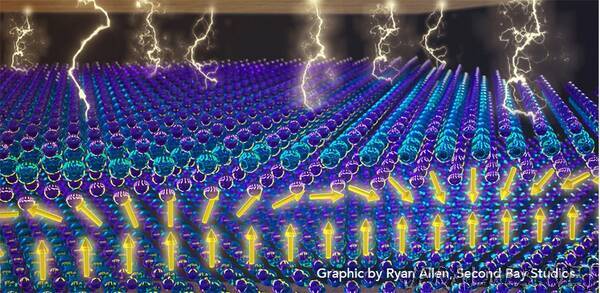
“Twistronics isn’t a new dance move, exercise equipment, or new music fad. No, it’s much cooler than any of that. It is an exciting new development in quantum physics and material science where van der Waals materials are stacked on top of each other in layers, like sheets of paper in a ream that can easily twist and rotate while remaining flat, and quantum physicists have used these stacks to discover intriguing quantum phenomena.
Adding the concept of quantum spin with twisted double bilayers (tDB) of an antiferromagnet, it is possible to have tunable moiré magnetism. This suggests a new class of material platform for the next step in twistronics: spintronics. This new science could lead to promising memory and spin-logic devices, opening the world of physics up to a whole new avenue with spintronic applications.
Now, a team of quantum physics and materials researchers has introduced the twist to control the spin degree of freedom, using CrI3, an interlayer-antiferromagnetic-coupled vdW material, as their medium. Their findings were published in Nature Electronics on June 19, 2023.
The team was led by Professor Yong P. Chen, a principal investigator at Tohoku University’s Advanced Institute for Materials Research (WPI-AIMR). Chen is also a professor at Purdue University in the USA and Aarhus University in Denmark.
“In this study, we fabricated twisted double bilayer CrI3, that is, bilayer plus bilayer with a twist angle between them,” says Dr. Guanghui Cheng, who performed the experiments for the study and is now an assistant professor in Chen’s laboratory at WPI-AIMR, “We report moiré magnetism with rich magnetic phases and the significant tunability by electrical method.”
“We stacked and twisted an antiferromagnet onto itself and voila got a ferromagnet,” says Chen. “This is also a striking example of the recently emerged area of ‘twisted’ or moiré magnetism in twisted 2D materials, where the twisting angle between the two layers gives a powerful tuning knob and changes the material property dramatically.”
“To fabricate twisted double bilayer CrI3, we tear up one part of bilayer CrI3, rotate and stack onto the other part, using the so-called tear-and-stack technique,” explains Cheng. “Through magneto-optical Kerr effect (MOKE) measurement, which is a sensitive tool to probe magnetic behavior down to a few atomic layers, we observed the coexistence of ferromagnetic (FM) and antiferromagnetic (AFM) orders, which is the hallmark of moiré magnetism and further demonstrated voltage-assisted magnetic switching. Such a moiré magnetism is a novel form of magnetism featuring spatially varying ferromagnetic and antiferromagnetic phases, alternating periodically according to the moiré superlattice.”
Twistronics up to this point have mainly focused on modulating electronic properties, such as twisted bilayer graphene. The research team wanted to introduce the twist to spin degree of freedom and chose to use CrI3, an interlayer-antiferromagnetic-coupled vdW material. The result of stacked antiferromagnets twisting onto itself was made possible by having fabricated samples with different twisting angles. In other words, once fabricated, the twist angle of each device becomes fixed, and then MOKE measurements are performed.
Theoretical calculations for this experiment were performed by a group from Purdue University led by Pramey Upadhyaya, corresponding author of the paper along with Yong P. Chen. This provided strong support for the observations arrived at by Chen’s team.
“Our theoretical calculations have revealed a rich phase diagram with non-collinear phases of TA-1DW, TA-2DW, TS-2DW, TS-4DW, etc.,” said Upadhyaya.
This research folds into an ongoing research avenue by Chen’s team. This work follows several related recent publications by the team related to novel physics and properties of “2D magnets,” such as “Emergence of electric-field-tunable interfacial ferromagnetism in 2D antiferromagnet heterostructures,” which was recently published in Nature Communications. This research avenue has exciting possibilities in the field of twistronics and spintronics.
“The identified moiré magnet suggests a new class of material platform for spintronics and magnetoelectronics,” says Chen. “The observed voltage-assisted magnetic switching and magnetoelectric effect may lead to promising memory and spin-logic devices. As a novel degree of freedom, the twist can be applicable to the vast range of homo/heterobilayers of vdW magnets, opening the opportunity to pursue new physics as well as spintronic applications.”
Publication Details:
Title: Electrically tunable moiré magnetism in twisted double bilayers of chromium triiodide
Authors: Guanghui Cheng, Mohammad Mushfiqur Rahman, Andres Llacsahuanga Allcca, Avinash Rustagi, Xingtao Liu, Lina Liu, Lei Fu, Yanglin Zhu, Zhiqiang Mao, Kenji Watanabe, Takashi Taniguchi, Pramey Upadhyaya and Yong P. Chen
Journal: Nature Electronics
DOI: 10.1038/s41928-023-00978-0”
